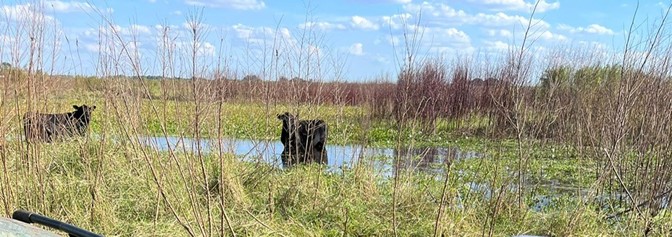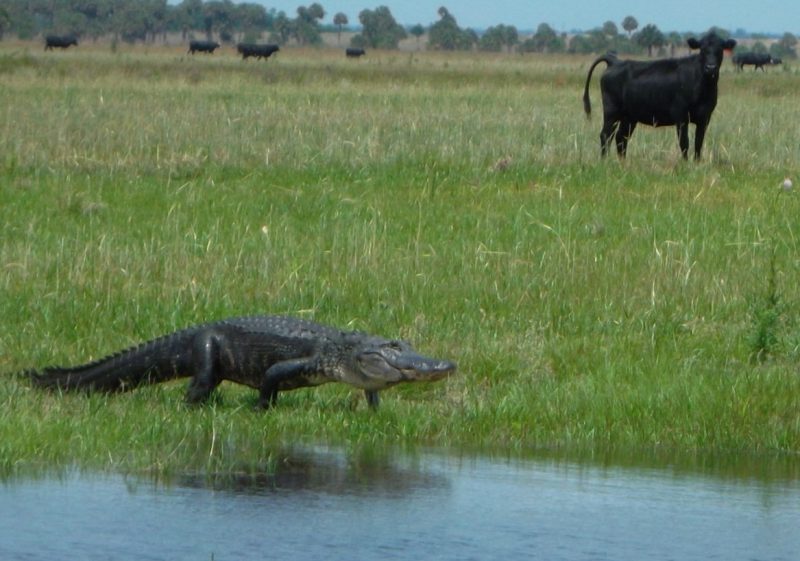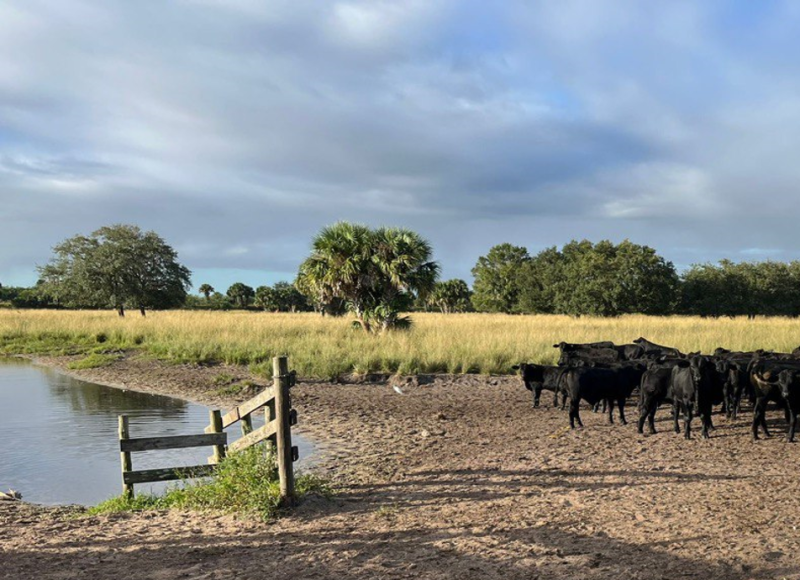Bruna A. Feliciano; Beatriz S. Nemoto; Ameer A. Megahed; Alireza R. Shahraki; Viviani Gomes; João Bittar, UF/IFAS Beef Cattle Extension Veterinarian
Leptospirosis (aka Lepto) is a disease caused by a spirochete bacterium belonging to the genus Leptospira and subdivided into serovars. The serovar can be adapted to the host, whereas the infected animal is the reservoir of the disease. When the serovar is not adapted to the host, the animal is infected incidentally.4 Humans can contract the disease when exposed to urine-contaminated soil or water; therefore, it is considered zoonosis and is important in rural and urban environments (Ellis, 2015). Cattle, in particular, are a common livestock reservoir. In addition to being considered one of the most important bacterial zoonoses in the world, Leptospirosis is one of the leading causes of economic losses in livestock, mainly in countries with tropical or subtropical climates, where the humidity and heat favor the Leptospira survival, putting Florida in a risky position for the transmission of this bacterial disease. Leptospirosis is one of the major causes of reproductive failures in ruminants, leading to abortions, repeated estrus, stillbirths, weak calves, decreased growth performance, and lower milk production. Also, outbreaks of infertility, agalactia in dairy herds, and increased culling rates are major causes of economic losses, making Leptospirosis a disease that significantly impacts beef and dairy cattle production.
In cattle, serovars of Leptospira spp. are of significant importance, including L.borgpetersenii serovar Hardjo and L. interrogans serovars Hardjo and Pomona. Depending on the geographic region, other serovars such as Icterohaemorrhagiae, Grippotyphosa, and Bratislava may have a considerably higher prevalence. This silent disease can go unnoticed and undiagnosed, compromising reproductive efficiency with a consequent decrease in the productivity performance of herds over long periods. When investigating any bovine reproductive problem, Leptospirosis should be considered when an infectious cause is suspected.
Cattle contract leptospirosis directly from animals or indirectly through the contaminated environment with urine, aborted fetuses, or infected uterine secretions of animals suffering with Leprostiporis. Some ways the leptospirosis infection is introduced into the herd are by bringing infected cattle to the farm, allowing naïve cattle to graze with infected cattle, or allowing them to have access to contaminated feed and/or water supplies especially standing water such as ponds, lagoons, retention areas, drainage water, swamps, floods, streams, or rivers. The organisms enter the body through the membranes of the eyes, nose, mouth, and even the skin, especially if it is injured or softened by water.
The susceptibility of cattle to Leptospirosis varies according to several factors, such as age, sex, physiological status, purpose, and stock density. This disease also has rodents as the main reservoirs, and rodents’ direct contact with bovine feed is also a significant risk factor to be aware. Infected dogs or other canids on rural properties have also been identified as a risk factor. However, do not forget that cattle are responsible for maintaining the disease. A viable infected newborn can harbor the infection for several weeks after birth and become an important source of transmission. In L. interrogans serovar Hardjo infections, the bacteria are excreted through the genital tract of cows for up to 8 days after abortion or parturition and are detectable in the oviducts and uterus for up to 90 days in infected cows. In addition, semen from an infected bull may contain Leptospira, and transmission by natural breeding or artificial insemination may occur. Leptospira organisms can survive in the environment for weeks to months, depending on environmental conditions, and some organisms have been shown to survive in stagnant, standing water or in moist soil for more than six months if the temperature is favorable (between 50°F and 93°F).

Leptospira organisms can survive been shown to survive in stagnant, standing water for more than six months. Credit: Joao Bittar, UF/IFAS
–
It is important to state that death is not the main cause of losses for producers but abortions (up to 30%) and loss of milk production. When animals present clinical disease, the morbidity rate (number of sick animals out of the total animals exposed) may vary from 10% to 30%, depending on the clinical manifestation of the infection, and the case–fatality rate is usually low at about 5%. On the other hand, the case-fatality rate in calves is much higher than in adult cattle, and deaths in calves may also be a significant loss. The clinical signs of leptospirosis depend on the degree of protection of the herd and its immunity, the infecting serovar, and the age of the infected animal. In herds with adequate protection, ideally developed through a good vaccination program or, in some cases, natural exposure, cattle may be infected with the organism but not show signs of the disease. However, in herds with low protection, infected animals with Leptospira may show mild to severe clinical signs of the disease.
The infected animal will only show clinical signs about 7 days after initial exposure and infection. Leptospirosis can be classified accordingly to the duration of the infection, and it can be acute (short term), subacute (medium term), or chronic (long term). Young animals (up to 1 month of age) are more susceptible to acute Leptospirosis, manifesting high fever (105° F – 107° F), loss of appetite, depression, blood in the urine, jaundice (yellowing of the skin and eyes), and pale mucous membranes. For adult animals, some clinical signs only occur in pregnant or lactating cows. Moreover, there can be abortion, which occurs more frequently in the second half of pregnancy, but can also occur at any time after 4 months; stillbirths; or weak calves. Infertility is another problem caused by Leptospirosis, and it can be translated as a decrease in the conception rate, an increase in the number of services per conception, and an increase in the calving-to-conception interval. In addition, it can cause a decrease in milk production, and it can affect up to 50% of cows at once. Also, it may cause changes in milk quality, such as thickened, reddish, or yellowish secretion, containing clots, and inducing flaccidity and softness of the mammary gland. When the disease becomes chronic, some animals may not show any clinical signs, which is a problem for the producers because, despite not showing any clinical signs, the cattle continue to transmit Leptospirosis through their urine and are a source of Leptospira and can transmit to other animals.
Diagnosis of Leptospirosis can be challenging due to the features of this disease. However, vaccination is a good method of prevention, but Leptospirosis vaccines should be used every 4 to 6 months due to their short duration of immunity.
If you suspect Leptospirosis in your herd or want to learn more about it, we encourage working closely with your veterinarian to develop a good diagnostic-treatment plan and prevention program to avoid the substantial losses that cattle can incur from this disease.
–
References
Brod, C.S., Fehlberg, M.F. 1992. Epidemiology of leptospirosis in cattle. Rural Science, Santa Maria. 22 (2). Pages 239-245.
Constable, P.D. et al. 2017. Veterinary Medicine: A textbook of the Diseases of Cattle, Horses, Sheep, Pigs, and Goats. Copyright, Elsevier Ltd. Volume 1. 11th Edition. Pages 1115-1128.
Ellis, W.A. 2015. Animal Leptospirosis. Current Topics in Microbiology and Immunology, v.387, p. 99-137. DOI:.
Fávero, J.F., Araújo H.L., Lilenbaum, W., Machado, G., Tonin, A.A., Baldissera, M.D., Stefani, L.M., Silva, A.S. 2017. Bovine leptospirosis: Prevalence, associated risk factors for infection and their cause-effect relation. Microbial Pathogenesis, Volume 107, Pages 149-154.
Rodning, S.P., Edmondson, M.A., Gard, J.A., Lovelady, A.S. 2017. Leptospirosis in Cattle. Alabama Cooperative Extension System. ANR-0858.
- Leptospirosis in Cattle:Why You Should Know More About It? - July 11, 2025
- Dangers of Toxic Algae Blooms for Cattle: Risks and Prevention Strategies - December 20, 2024
- Gastrointestinal (GI) Parasites of Beef Cow-Calf Operations in Florida - June 14, 2024


